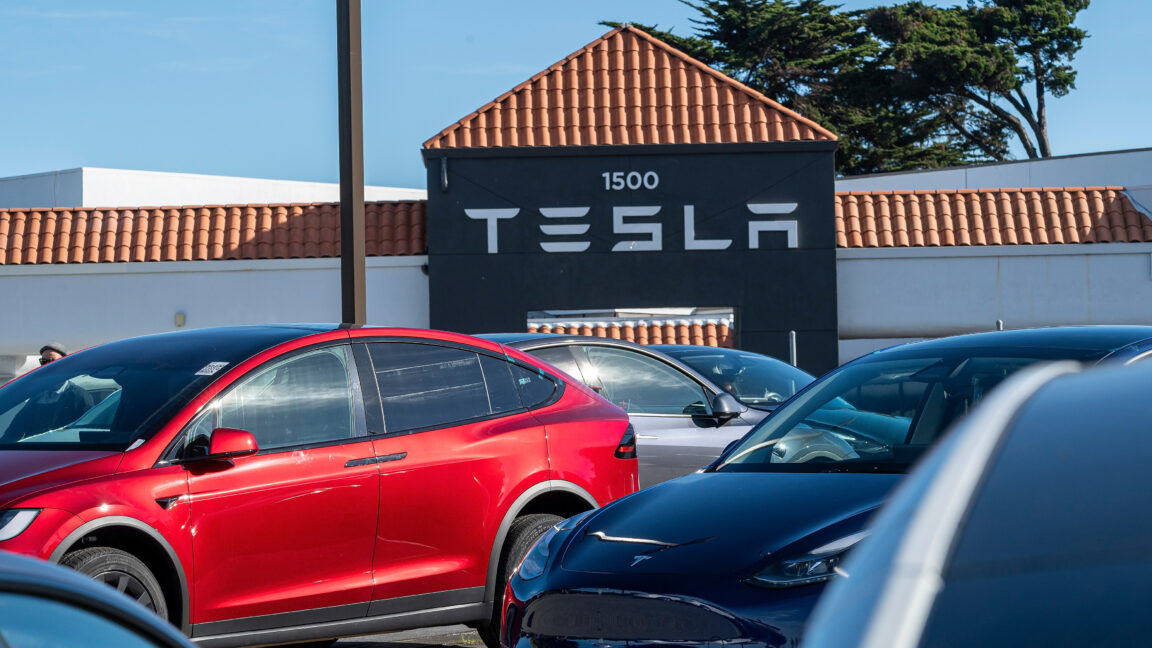Tesla changes lease policy, didn’t use old cars as robotaxis
you believed that?
Tesla changes lease policy, didn’t use old cars as robotaxis
From 2019–2024, Tesla would not offer a buyout to lease customers.
Jonathan M. Gitlin
–
May 15, 2025 2:29 pm
|
83
Vehicles at a Tesla store in Colma, California, US, on Wednesday, Dec. 13, 2023.
Credit:
David Paul Morris/Bloomberg via Getty Images
Vehicles at a Tesla store in Colma, California, US, on Wednesday, Dec. 13, 2023.
Credit:
David Paul Morris/Bloomberg via Getty Images
Story text
Size
Small
Standard
Large
Width
*
Standard
Wide
Links
Standard
Orange
* Subscribers only
Learn more
Tesla has raised the ire of some of its customers, who are accusing the carmaker of misleading them. Until recently, it would not allow customers who leased its EVs to purchase them at the end of the lease. Instead, the leases stated that it "planto use those vehicles in the Tesla ride-hailing network."
Tesla instituted that policy for Model 3 leases starting in 2019 and later expanded it to the Model Y until changing the policy last November. But Tesla is not currently sitting on a fleet of several hundred thousand ex-lease autonomous Models 3 and Y, and as of today there exists no actual Tesla ride-hailing network.
Instead, it has been spiffing up the ex-lease cars with software updates and then selling them to new customers, according to Reuters. And that has made some former leasers a little unhappy that their old EVs weren't pressed into service making money for Tesla on an ongoing basis but rather just as a one-time transaction.
Although Tesla Models 3 and Y depreciate heavily now, that was not the case for much of the duration of the "no buyout" policy. Were buyouts permitted then, it's likely that the buyout amount would exceed the actual value of those 3-year-old Teslas, which therefore may possibly have done these aggrieved owners a favor.
In the meantime, Tesla's share price benefited heavily from CEO Elon Musk's constant promotion of the cars' supposed ability to drive themselves and the scale this would enable for a putative ride-hailing network. If his word is to be believed, autonomous Teslas will start offering rides in Austin, Texas, next month.
Jonathan M. Gitlin
Automotive Editor
Jonathan M. Gitlin
Automotive Editor
Jonathan is the Automotive Editor at Ars Technica. He has a BSc and PhD in Pharmacology. In 2014 he decided to indulge his lifelong passion for the car by leaving the National Human Genome Research Institute and launching Ars Technica's automotive coverage. He lives in Washington, DC.
83 Comments
#tesla #changes #lease #policy #didnt
Tesla changes lease policy, didn’t use old cars as robotaxis
you believed that?
Tesla changes lease policy, didn’t use old cars as robotaxis
From 2019–2024, Tesla would not offer a buyout to lease customers.
Jonathan M. Gitlin
–
May 15, 2025 2:29 pm
|
83
Vehicles at a Tesla store in Colma, California, US, on Wednesday, Dec. 13, 2023.
Credit:
David Paul Morris/Bloomberg via Getty Images
Vehicles at a Tesla store in Colma, California, US, on Wednesday, Dec. 13, 2023.
Credit:
David Paul Morris/Bloomberg via Getty Images
Story text
Size
Small
Standard
Large
Width
*
Standard
Wide
Links
Standard
Orange
* Subscribers only
Learn more
Tesla has raised the ire of some of its customers, who are accusing the carmaker of misleading them. Until recently, it would not allow customers who leased its EVs to purchase them at the end of the lease. Instead, the leases stated that it "planto use those vehicles in the Tesla ride-hailing network."
Tesla instituted that policy for Model 3 leases starting in 2019 and later expanded it to the Model Y until changing the policy last November. But Tesla is not currently sitting on a fleet of several hundred thousand ex-lease autonomous Models 3 and Y, and as of today there exists no actual Tesla ride-hailing network.
Instead, it has been spiffing up the ex-lease cars with software updates and then selling them to new customers, according to Reuters. And that has made some former leasers a little unhappy that their old EVs weren't pressed into service making money for Tesla on an ongoing basis but rather just as a one-time transaction.
Although Tesla Models 3 and Y depreciate heavily now, that was not the case for much of the duration of the "no buyout" policy. Were buyouts permitted then, it's likely that the buyout amount would exceed the actual value of those 3-year-old Teslas, which therefore may possibly have done these aggrieved owners a favor.
In the meantime, Tesla's share price benefited heavily from CEO Elon Musk's constant promotion of the cars' supposed ability to drive themselves and the scale this would enable for a putative ride-hailing network. If his word is to be believed, autonomous Teslas will start offering rides in Austin, Texas, next month.
Jonathan M. Gitlin
Automotive Editor
Jonathan M. Gitlin
Automotive Editor
Jonathan is the Automotive Editor at Ars Technica. He has a BSc and PhD in Pharmacology. In 2014 he decided to indulge his lifelong passion for the car by leaving the National Human Genome Research Institute and launching Ars Technica's automotive coverage. He lives in Washington, DC.
83 Comments
#tesla #changes #lease #policy #didnt
0 Comentários
·0 Compartilhamentos
·0 Anterior




